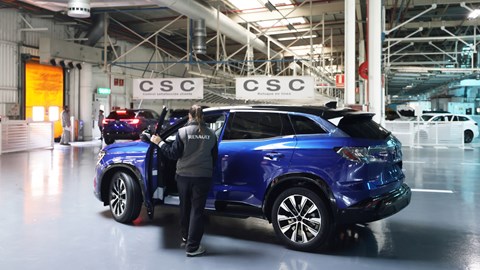- We get behind the curtain at Renault
- With exclusive access to firm’s R&D centre…
- … and a peek at the brand’s production lines
In December 2022, Renault invited us to Spain for a tour of its Valladolid R&D centre and its Palencia plant. Valladolid is the pinnacle of innovation for Renault’s E-Tech hybrid powertrains, while the Palencia plant currently handles production of the petrol Megane and the new Austral SUV.
We were hoping to use the trip to gather some information about the company’s future product launches but, sadly, Renault’s PR team anticipated our intentions and moved all its interesting prototypes to a back shed, away from prying eyes. Still, we managed to extract some basic details about the upcoming cars from executives present at the event.

Renault has confirmed it’ll launch a total of five new models between 2022 and 2024, including the Austral. The as-yet unseen vehicles will include a pair of B-segment SUVs, a C-segment crossover and a D-segment SUV. Palencia will handle production of the Austral and the two larger SUVs, as they’ll all be based on the Renault Group’s CMF-CD underpinnings. As such, those were the cars we pressed for during our tour.
What will these new cars look like?
Nadjib Zaouche, Palencia’s plant manager, hinted that the new C- and D-segment vehicles will both be ‘derivatives’ of the Austral rather than clean-sheet cars. So, we expect they’ll will share their front-end styling with the Austral but have distinct rears to broaden their appeal to different buyers.
When quizzed about how many common components the new cars will share with the Austral, he said: ‘[the cars] will be in the same platform, so you can imagine that it’s going to be some new parts, but it’s not a transformation. It’s not going to be a big revolution for the new models.’
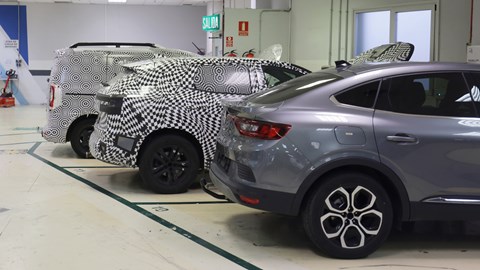
We’ve already spotted the larger SUV tackling its development programme. It’s a longer, seven-seat version of the Austral with a slightly taller roofline, which we expect will be called the Grand Austral. In essence, it’ll plug the gap left by the Grand Scenic MPV’s death and allow Renault to compete with the likes of the Peugeot 5008, Skoda Kodiaq and Kia Sorento.
We know less about Renault’s other C-segment model but, judging by the shrugs and smirks of the representatives at the plant, we reckon it’ll be a coupe-ish crossover designed to rival the Citroen C4. Renault insiders hint that the company is planning to stay in the coupe-SUV segment and is aiming to launch something a little more premium than the Arkarna.
What’ll they be powered by?
The same 197bhp 1.2-litre three-cylinder hybrid system as the Austral. There’ll also be a couple of mild hybrids which we won’t get in the UK and, more interestingly, a plug-in hybrid powertrain.
Renault’s new PHEV system is still undergoing development. During our tour of the Valladolid R&D centre, we walked into Renault’s engine prototyping shed. In there, the company’s engineers were assembling a 400-volt battery pack that’ll feed the motor in the upcoming PHEV system. It’ll be mated to the same 1.2-litre petrol engine found in the Austral’s full hybrid powertrain.
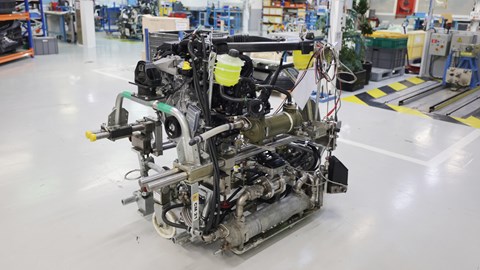
Jose Martin Veiga, Renault’s Industrial Director for Iberia, wouldn’t be drawn on details such as battery capacity, targeted electric range and prospective fuel economy figures. However, to be competitive in the segment, the new PHEV powertrain will need to be able to cover around 35 miles on electric power alone and return upwards of 100mpg.
It’s also worth mentioning that Renault’s 1.2-litre hybrid and plug-in hybrid powertrains have nothing in common with Alliance partner Nissan’s e-Power system. That seems like a needless doubling-up of work, but Veiga says Renault’s powertrain is better suited to European buyers.
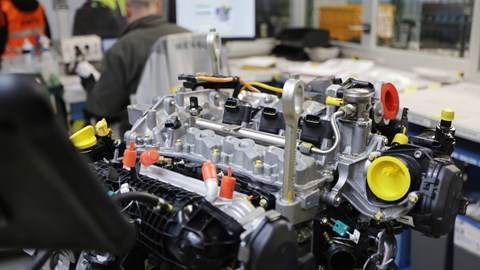
‘From a performance point of view, there is absolutely no comparison [between e-Power and E-Tech],’ he said. ‘We are launching Austral mainly for Europe – and Europe is looking for CO2. If you want to do that, the best performance is E-Tech. But e-Power is quite oriented for Asia.’
How will these new cars be built?
Renault has this figured out rather well. Palencia only deals with the Group’s CMF-CD architecture – and that means it can send any car on that platform down the same production line. Standing in the body shop, we watched a Megane hatchback roll past, followed by an Austral, followed by a Megane estate. They were all in different stages of assembly, too.
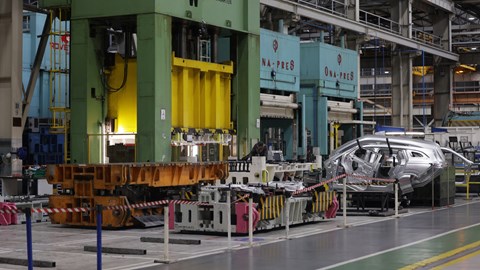
Zaouche assured us that tacking a couple more derivatives of the Austral onto this process won’t be a problem for the plant. Palencia churned out 98,000 vehicles in 2022 because of supply chain issues but he tells us that in 2023, with the arrival of the Austral and the first of these two new SUVs, his facility will massively scale up its efforts. He says the plant will soon produce 1,300 vehicles per day.
The process starts in the stamping shop, in which enormous presses punch out panels from rolls of steel and aluminium weighing between eight and 15 tonnes. The presses stamp out around 56,000 panels every day, with operators swapping tools four times on an eight-hour shift to allow the machine to produce different parts of the car’s body.
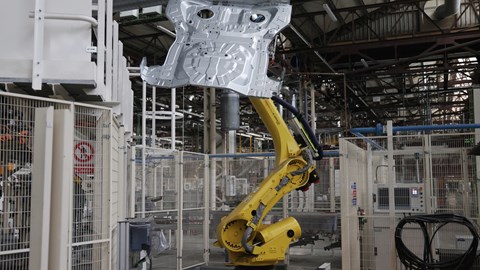
These pressed panels are then transported to the body shop, where an army of robots weld them together. The lines are fed by a hive of autonomous transport robots which tow racks of parts from the stamping shop between the different welding stations. Handler robots then lift the panels off the racks and hold them in place for welder robots to zap them together with almost 4000 spot welds. It takes around 10 hours for the rolls of steel and aluminium to be transformed into a bodyshell.
Renault has also invested in some labour-saving machinery for its workforce, such as a no-touch mounting system for its car doors. The door is lifted off the transport rack and offered up to the car by a robotic arm – and the worker simply bolts it in place.

Once the body is finished, it passes through the paint shop, where 18.7kg of paint and sealant are applied. It takes a full day for one car body to be completely painted. On the way out of the paint shop, the body is scanned by a camera array that searches for imperfections in the paint and passes the message on to workers further up the line to make corrections. It isn’t perfect, though. We saw a white Megane rolling down the line with a red streak on its door frame.
Then it’s on to assembly. It’s a balletic process. Parallel assembly lines for items like the powertrain, exhaust system and dashboard converge with the correct car at the perfect time to be bolted into place. Each shell also has its own dedicated autonomous robot that follows it along the line with a tray of parts, which workers pick through as the assembly process advances.
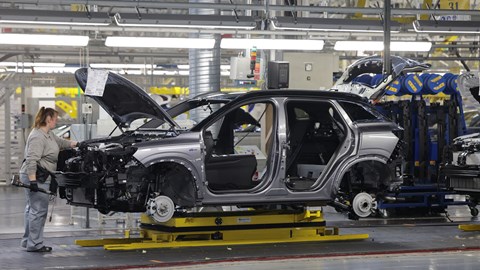
The scale of the project is impressive, as is the speed. Renault says it takes just 24 hours to build a car from start to finish – and, once the painted body shell hits the final assembly line, it’s pieced together in just four-and-a-half hours. Stand at the end of the production line for an hour and you’ll watch 60 brand-new cars roll past.
What will happen to Palencia in the future?
For the time being, its future is secured. Renault is turning Palencia and Valladolid into its hybrid vehicle production hub. Even though the market is shifting ever more gradually to pure-electric vehicles and the 2035 European ban on new combustion vehicles is looming large, the company is continuing to pour money into combustion engine development.
Renault’s operations in Spain account for 8.4% of its total output. What’s more, 85% of the vehicles produced in Palencia are shipped out of the country which, to phrase that another way, makes up around 5% of all Spanish exports. That’s a huge chunk of income that Renault is keen to cling to.
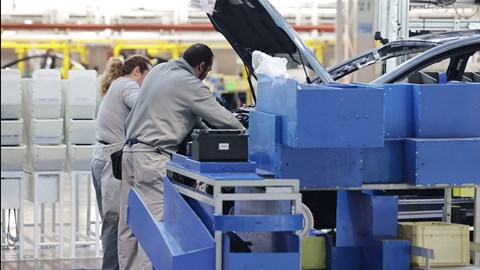
Renault can also get around Europe’s petrol engine ban by selling its cars to other markets with less stringent emissions laws (such as Africa and Latin America) – and the revenue it can earn from that is significant enough to justify the continuing development of its hybrid system.
Sounds a bit behind the times. Is Renault going green at all?
Of course. Just not everywhere all at once. Renault has already confirmed that it’ll launch of two new retro-styled EVs by the middle of the decade. In 2024, the firm will launch its reincarnated Renault 5 hatchback, followed by a reimagined version of the Renault 4 in 2025. The brand’s CEO, Luca de Meo, has also confirmed that the next-generation Scenic will make its debut in 2024 – and that car is also expected to feature a pure-electric powertrain. Renault’s factories are going green, too.
To compensate for the fact its Palencia facility will continue churning out petrol cars until the end of the decade, Renault has fitted it with more than 23,000 square metres of solar panels and a fancy water treatment system that ensures the water leaving the plant is cleaner than the water that arrived at it. Palencia also has a rigorous waste management system and recycles 99.5 percent of the materials thrown in its skips.
